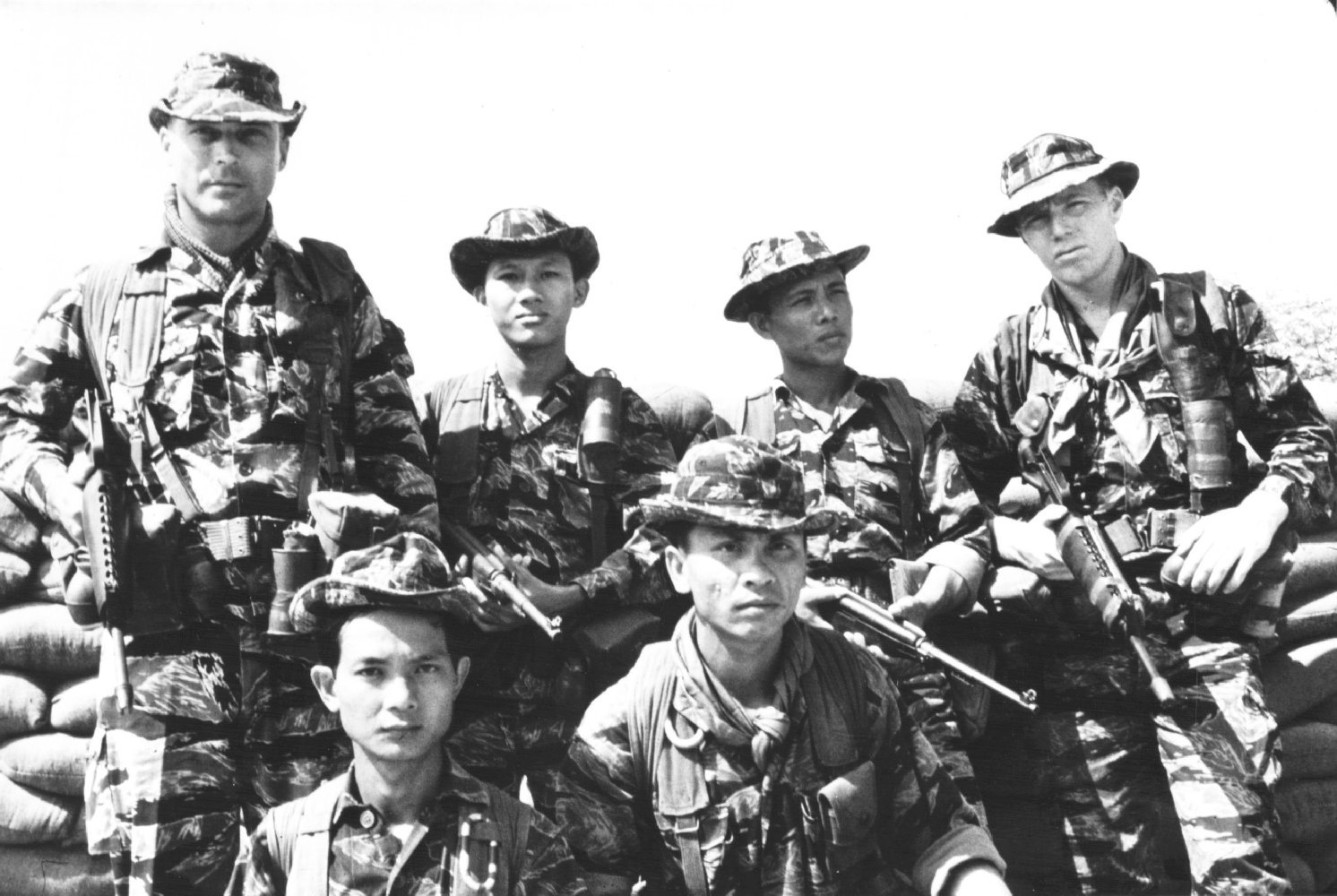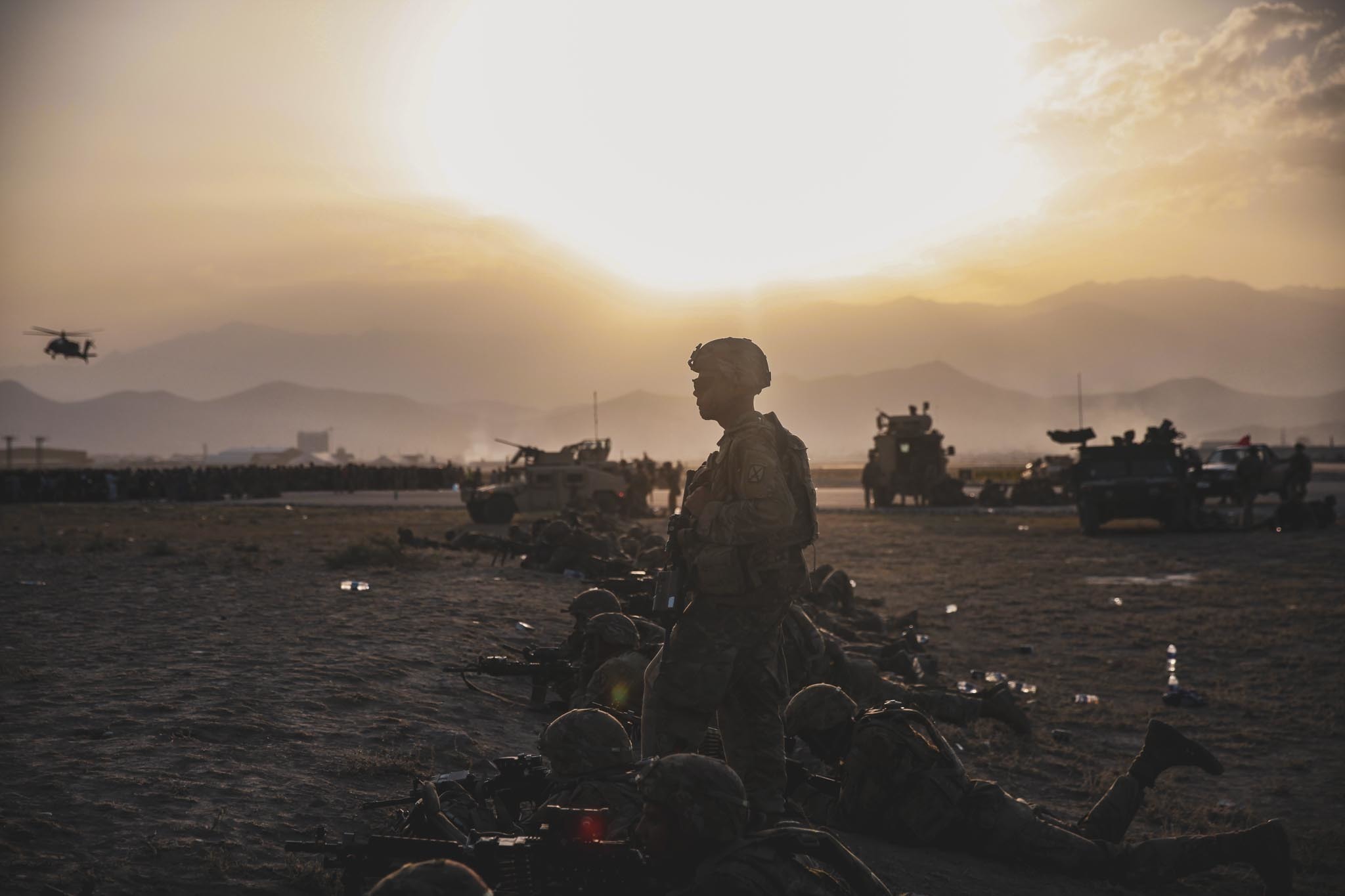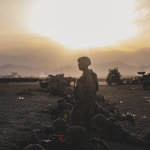Last August people across the United States sat in horror as they saw the Government of Afghanistan capitulate to the Taliban. The scenes of mass Afghan Army surrenders and people clamoring to get out of Kabul riveted people to the news. In a flash, after 20 years, the Taliban was back in power. The world had not seen anything like it since Vietnam and both isles of Congress asked how such a thing could occur. The US had spent $145bn over 20 years to rebuild Afghanistan; $83bn of which went to the Afghan army and police forces to build stability.1 2,448 US service personnel and 3,846 contractors were killed in Afghanistan.2 Both President Biden and Joint Chiefs of Staff Chairman General Mark Milley told various press outlets and Congressional committees that the fall of Afghanistan was a complete surprise.3 Many people across the country thought that the nation’s blood and treasure sacrifice would have purchased some sort of stability for Afghanistan.
This op ed argues that the collapse of Afghanistan stems from a failure of strategic doctrine that started with President Nixon and Vietnam. To be successful, this piece makes the case for auxiliary forces.
Context
The failure in Afghanistan lies in the shadow of President Richard M. Nixon. Nixon served as Eisenhower’s Vice President in the 1950s before losing the 1960 presidential election against John Kennedy. Nixon ran again for President in 1968. That year, American politics was torn apart because of its commitment to the Vietnam war and protests raged against the war on an almost daily basis.
Against this context Nixon found himself in a dilemma. To win the election he needed to do the impossible. Peace protestors demanded an immediate withdrawal, but this in itself would risk world peace and stability. He had to devise a solution that would end the Vietnam war without isolating support from either the hawks or doves. Nixon campaigned across the nation saying he would de-Americanize the war.4 During the election debate Nixon’s plan was categorized by the media as a ‘secret’. The term ‘secret plan’ stuck in the press accounts for the rest of the election.5 Despite a lack of detail, the public give Nixon the benefit of the doubt and he was elected President.

The ‘secret plan’ only took shape after the election. During the campaign Nixon only said that he had to ‘de-Americanize’ the war. That term ‘Vietnamization’ emerged almost by accident. It was first used by Defense Secretary Laird in interview on Meet the Press on March 23rd 1969. Nixon agreed with the term and after that it was used by the Administration.6
President Nixon explained his plan, Vietnamization, to the nation in November 1969.7 America would build up South Vietnam forces as American ones pulled out. This new plan became known as the Nixon doctrine. Domestically, the policy was brilliant. This policy of Vietnamization gave everyone across the political spectrum something. The plan gave President Nixon a way to both maintain US commitments up whilst offering hope for an end to the war.
The plan gave President Nixon a way to both maintain US commitments up whilst offering hope for an end to the war.
Although MACV (Military Assistance Command Vietnam) did have a program to advise the South Vietnam Army (AVRN) it was accelerate drastically after Nixon’s speech. By the conclusion of the war the South Vietnam Army had grown in size from c.200,000 troops in 1962 to 750,000 by 1975. However, only 150,000 of that number were combat troops.8 This new South Vietnam Army would be designed to concentrate on withstanding an invasion from the north.9 The new structure was based on the US model and would use US equipment and doctrine.10

United States implemented a comprehensive training program to show the South Vietnamese how to use their new tools of war. Personnel of all ranks would receive training about every facet of operations through an elaborate school system that had been established across the country. South Vietnamese Air Force pilots were even moved to the US for training. The US Government spent significant sums of money putting all prospective pilots through extensive English language training prior to their training.11
Nixon’s thumb print
After 9/11 the US found itself in another war but Nixon’s thumb print is clear when looking at both Afghanistan and Iraq. US forces planned to build up both the Afghan and Iraqi Armies to help win the war. Both nations received significant military assistance. Over a 20-year period the US provided Afghan forces with at least 600,000 infantry weapons, 162,000 pieces of communication equipment, and 16,000 night-vision goggle devices. The Afghan Army received over 2,000 armored vehicles of various kinds to include Humvees, M117 Armored Cars, MRAP personnel vehicles and 40 aircraft.12 The choice of weapons reads like a standard shopping list for countries all over the world. Many of these vehicles had performed superbly in many places. However, the unique terrain of Afghanistan takes away the advantages of these vehicles and many were not suitable. The MRAP and the M117 are very large vehicles weighing more than 17 tons. Their size and weight become a problem in Afghanistan where bridges, especially ones that can take heavy vehicles, and are vulnerable points.
The Afghan Air Force received similar support from the US. The US would attempt to field a modern air force in a country which hadn’t had one before. The Afghan Airforce of July 2021 had 160 aircraft of all kinds; a mix of modern fighters, ground support aircraft, transports, and helicopters. Before the fall of Kabul, the US Government planned to purchase an additional 53 UH-60 helicopters to supplement the 45 they already had.13
Iraq
The US followed Nixon’s doctrine in Iraq. They had a multi-year approach to build a 150,000-strong army and a police force of over 80. The US also strove to create a whole infrastructure to support the Iraqi Government. In seven years starting in 2004, the U.S. Army Corps of Engineers completed more than 5,000 projects with a value of $8.8 billion in Iraq.14
In the words of the movie character Austin Powers, the US created a series of ‘mini me’ militaries.
The problem with Nixon’s strategy
The possession of equipment doesn’t equate into capacity. The US provided extensive support to the armed forces of Vietnam in a short time frame. The Government of South Vietnam quickly found they could not afford the equipment which they inherited. South Vietnam commanders were trained in the US model to use massive firepower. The South Vietnamese Government had trouble paying for and supplying this habit. As one ARVN division commander commented [we were] ‘trained as they were through combined action with US units, the [South Vietnamese] unit commander was used to the employment of massive firepower.’ That habit, he added, ‘was hard to relinquish.’15 As the Vietnam war continued these problems intensified. South Vietnam lacked the money to keep going and their benefactor, the United States, grew tired of paying the bill. The US Congress would cut off the cash flow in 1975.

US records indicated that South Vietnam forces were plagued by poor maintenance and shortages of spare parts. These problem impact readiness states. Much of the equipment provided under ‘Vietnamization’ became inoperable due to supply problems. A rise in fuel prices further restricted South Vietnam’s use of vehicles and aircraft. Shortages of fuel, oil, and spare parts curtailed operations of the South Vietnamese Air Force by 50%.16 In 1974, as North Vietnam closed in on Saigon, the US found their ‘mini me army’ needed $722 million just to maintain a minimal defense posture. The same trend continued in 1975 when $1.6 billion was requested to maintain a viable military capability. $700 million was provided, 44% of stated requirement.17
Slow is smooth. Fast is not.
Every organization needs a bureaucracy to run the business. A good example of the implication of not having a good backroom operation is evident when looking at the Afghan Air Force. In August 2021 over 50 of their aircraft were unavailable due to a lack of spare parts. Even if parts were available, no one knew how to put the part onto the aircraft. The US pulled supporting contractors out before the collapse, further undermining the supporting structure. That, in turn, grounded Afghan aircraft faster than any Taliban surface to air missile ever could have. Five of the Afghan Air Force’s seven types of aircraft saw dramatic drops in their availability in the months before August 2021. In April and May 2021 their fleet of AC-208 Combat Caravans had a 93% readiness rate. In June 2021 that fell to 63%. Its UH-60 Black Hawk fleet saw an even steeper plunge, from 77% to 39%.
Quick fixes made in the theater can improve readiness and achieve short-term gains but they erode over time.
Quick fixes made in the theater can improve readiness and achieve short-term gains but they erode over time. The US Congress pushed the Afghan Government to purchase Blackhawk helicopters over the Russian Mi8 helicopter. The US could easily create a maintenance program for the helicopters with expensive contractors. Domestic politics undoubtably played a part in the decision to push US equipment. However, US equipment didn’t fit the situation. The simpler Russian models were something that the Afghan Government preferred and could maintain themselves. The Mi8 also performed better in high altitude environments. The maintenance support for Blackhawks was provided by contractors creating a dependency on the US which collapsed when the contractors were pulled out.
If the strategy doesn’t work, why use it?
First, it is a politically easy policy. Politicians can act tough but maintain an easy exit plan with limited military personnel deployed to fight a war. The policy is effective domestically. Lieutenant General H.R. McMaster puts it best when he calls it ‘strategic narcissism’. McMaster says people turn the fantasy that others are like ‘us’ into a perceived reality even if there is a preponderance of evidence to the contrary. There is a belief that simply giving others our equipment is an effective strategy. There is a tendency to assume the others will work just like us.18

Secondly, the policy fails to realize the limits of technology. Possession of equipment does not equate into capacity. This Nixon policy tends to forget the impact of the local cultural factors. Recently, Michael Zacchea, a retired USMC Lieutenant Colonel, described it best in an interview with CNBC, “We did not understand the tribal dynamics, we never did. We think everybody wants what we have. It’s cultural obtuseness, obliviousness to their reality”.19 That problem he described isn’t new. The Secretary of Defense in the Johnson Administration during the Vietnam War, Robert McNamara, said something similar about their failure in the war; “Strategy makers failed to recognize the limitations of modern technology and military equipment in confronting unconventional highly motivated people’s movements”.20
Tougher Questions
Because of domestic politics, and a general risk aversion, Nixon’s strategy seems here to stay. It’s time to ask why we haven’t learnt from this history? Why don’t we build forces for our friends which work and which they (and the US) can afford? One answer is knowledge and attitude. According to Marine Corps Veteran Dan Grazier “We lacked resident experts at the beginning. The Army and the Marine Corps defaulted to what they knew and tried to craft the Afghan Army in their own image”.21
Vietnamization has a further negative side effect in that it tends to assist future enemies. Martin Van Creveld put it best when discussing Vietnam; “When the Americans withdrew they still had mountains of equipment that hoped it would do their South Vietnamese allies some good. These mountains of equipment in turn fell into the hands of the North Vietnamese Army and formed one reason why it was able to throw back the Chinese in 1979”.22 The same thing happened in Afghanistan. Who knows where these weapons will go to next?
Conclusion: We need auxiliaries
After the 20 years of fighting in both Afghanistan and Iraq Western military planners will have to ask themselves what’s next. What are the lessons about building up local military forces? I would say history shows us that the option of dropping tons and tons of material on local forces with little training programmes doesn’t really work.
What other options do planners have? The Army should go way back in time past Vietnam to other wars; the Philippines and the Indian wars. The Army set up special units which utilized local personnel but with officers from the US. President Theodore Roosevelt officially made the Filipinos then serving with the American forces (5,000 men in 50 companies) part of the U.S. Army. For almost half a century the Philippine Scouts served America with courage and fidelity. A similar program currently works in South Korea. Local men from South Korea serve in US Army units. This auxiliary idea quickly builds capacity without pushing local soldiers into the deep, complex and mind blowing world of running an Army.
It’s not the only solution, of course. But auxiliary forces would remove Nixon’s thumb print and allow strategy makers to move past the failures of the post 9/11 era.

Thomas Magee
Thomas Magee is a retired US Army Reserve LTC Officer living in Kansas City MO. He lives in the Kansas City area with his wife Renee and their two dogs. He has experience in a wide range of assignments to include command spots, staff jobs, Desert Storm and in Iraq. His last duty assignment was as a reserve instructor in the Army Command and General Staff College at Ft. Leavenworth. LTC (R) Magee obtained his commission in the Reserve Officer Training Corp unit at the University of Kansas. He has an undergraduate degree from the University of KS, a Masters in Public Administration from the University of MO, Kansas City and a Masters in Communication from the University of Kansas. He is currently studying for a Masters in History from Arizona State University. Thomas Magee also has worked as a Federal Civil Servant for the past 31 years.
Footnotes
- “Billions Spent on Afghan Army Ultimately Benefited Taliban”, US News, August 17th, 2021, https://www.usnews.com/news/politics/articles/2021-08-17/billions-spent-on-afghan-army-ultimately-benefited-taliban.
- “Costs of the Afghanistan War, in Lives and Dollars”, US News , August 17th, 2021, https://www.usnews.com/news/politics/articles/2021-08-14/costs-of-the-afghanistan-war-in-lives-and-dollars
- Maureen Groppe, “Not even close: Biden said no one predicted Taliban would take over so quickly”, USA Today, August 19th, 2021, https://www.usatoday.com/story/news/politics/2021/08/19/biden-said-no-one-predicted-afghanistans-quick-fall-not-even-close/8191588002.
- Godfrey Sperling, “Nixon’s Secret Plan That Never Was”, Christian Science Monitor, December 9th, 1997, https://www.csmonitor.com/1997/1209/120997.opin.column.1.html
- “Again with the Secret Plan”, Richard Nixon Foundation, accessed October 13th, 2021, https://www.nixonfoundation.org/2010/04/again-with-the-secret-plan/.
- “Secretaries of Defense Historical Series, Melvin Laird and the foundation of the Post-Vietnam Military 1969 – 1973. Historical Office, Office of the Secretary of Defense, Washington DC, 2015, Page 104, https%3A%2F%2Fhistory.defense.gov%2FPortals%2F70%2FDocuments%2Fsecretaryofdefense%2FOSDSeries_Vol7.pdf&clen=42190525&chunk=true.
- President Richard Nixon Address to the Nation on the War in Vietnam, November 3, 1969, posted November 15th, 2017, https://www.youtube.com/watch?v=RPpOBu2LNCo spot 14:53.
- Walter J. Boyne, “The Fall of Saigon”, Air Force Magazine, April 1, 2000, 2, https://www.airforcemag.com/article/0400saigon/
- “Vietnam Studies, The Development and Training of the South Vietnamese Army 1950-1972”, (Washington D.C.: US Government, 1975), P 12.
- “Vietnam Studies, The Development and Training of the South Vietnamese Army 1950-1972”, (Washington D.C.: US Government, 1975), P 128.
- “Vietnam Studies, The Development and Training of the South Vietnamese Army 1950-1972”, (Washington D.C.: US Government, 1975), P 113.
- Idrees Ali and Patricia Zengerle, Jonathan Landay, “Planes, guns, night-vision goggles: The Taliban’s new U.S.-made war chest”, Reuters, August 19th, 2021, https://www.reuters.com/business/aerospace-defense/planes-guns-night-vision-goggles-talibans-new-us-made-war-chest-2021-08-19/
- Shawn Snow, “US cuts number of Black Hawks to Afghanistan by two-thirds”, Military Times, January 28th, 2020, https://www.militarytimes.com/flashpoints/2020/01/28/us-cuts-number-of-black-hawks-to-afghanistan-by-two-thirds/
- Rory Stewart & Gerald Knaus, Can Intervention Work? (New York: W.W. Norton, 2011) 31.
- The US Army in Vietnam, American Military History, Army Historical Series, United States Army Center of Military History, US Government, chapter 28, p 687, https://history.army.mil/books/amh/amh-28.htm.
- General Fred C. Weyand, “Vietnam Assessment Report 4 April 1975” Ford Library, accessed September 25th, 2021, www.fordlibrarymuseum.gov%2Flibrary%2Fexhibits%2Fvietnam%2F032400081-001.pdf&clen=21315927&chunk=true
- General Fred C. Weyand, “Vietnam Assessment Report 4 April 1975” Ford Library, accessed September 25th, 2021, www.fordlibrarymuseum.gov%2Flibrary%2Fexhibits%2Fvietnam%2F032400081-001.pdf&clen=21315927&chunk=true
- H. R. McMaster, Battlegrounds (New York: Harper Collins, 2020), 255.
- Natasha Turak, Abigail Ng & Amanda Macias, “‘Intelligence failure of the highest order’ — How Afghanistan fell to the Taliban so quickly”, CNBC , August 18th, 2021, https://www.cnbc.com/2021/08/16/how-afghanistan-fell-to-the-taliban-so-quickly.html
- Rory Stewart & Gerald Knaus, Can Intervention Work? (New York: W.W. Norton, 2011) 352.
- Tara Copp, “ The US Spent $83 Billion Training Afghan Forces, Why did they Collapse so Quickly?” Defense One, August 14th, 2021, https://www.defenseone.com/threats/2021/08/us-spent-83-billion-training-afghan-forces-why-did-they-collapse-so-quickly/184529/
- Martin Van Creveld, The Changing Face of War ( New York, Ballantine Press, 2008), 224.


